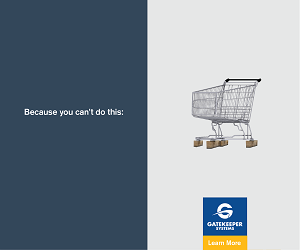Industry focus
Saving and Craving Stock—Re-Looking at The Bigger Picture of Retail Crime
April’s publication of The Crime Survey for England and Wales—revealing a 20 per cent increase in recorded shoplifting offences compared to the previous year—provided a depressing snapshot view of a larger canvas and the more complex contours of the retail landscape.
It told the retail industry what it already knew, or suspected, that the number of offences—516,971 recorded shoplifting offences compared to 429,873 in the previous year—continues the upward trajectory captured by the Office for National Statistics (ONS) trends which revealed the highest-ever recorded figures since current recording practices began in 2003.
As if to prove the point, it led the Association of Convenience Stores’ (ACS) chief executive James Lowman to comment: “The increase in shop theft shown by these figures reflects what our members are seeing every day in their stores. The volume of theft is still massively under-reported though—our own member survey revealed 6.2 million thefts recorded by convenience stores alone.”
“It is encouraging that more theft is being reported, even if it is still only the tip of the iceberg. Unless theft is reported, we cannot identify the repeat offenders who are responsible for so much of this crime. The Crime and Policing Bill gives more powers to the police and courts to deal with these offenders, and the Retail Crime Action Plan makes clear that shop theft must be investigated. It’s time that these plans were implemented across the country to support retailers and their colleagues.”
This analysis, whilst true, is however a rather reductive image. It lacks depth and the ability to horizon-gaze the bigger picture or the reality behind the figures. Indeed, it takes a rather binary view of how law enforcement will somehow provide the answer.
In so doing, it assumes narratives around the “cost-of-living crisis”, the societal reduction of tolerance and respect in a post-COVID world, and a lack of legal consequence for the 20 per cent of persistent and prolific offenders believed to carry out 80 per cent of offences are the main culprits.
However, more importantly, it fails to recognise the global impact of retail crime’s prime drivers—the highly-organised nature of industrial levels of theft and the laws of cause and effect which highlight the fact that for every stolen item there is usually a ready market for its rapid disposal.
Access to these grey and black markets in stolen and disposable goods—from physical market stalls to online social media portals that trade illicit goods—has never been so easy and prolific.
Reprise of Global Stolen FMCG Report
And it’s far from a new or UK-centric issue. The buying and selling of stolen or “illicit” goods is as prevalent as the buying and selling of legal or “licit” goods all across the world.
It is a mirror image of the legitimate business economy with its own global supply chains and outlets—from market stalls to pubs, or even other retailers to the online and social media platforms where few questions are asked of the seller in relation to an item’s provenance, providing the price is right.
Twenty years ago, Criminologist Professor Martin Gill of Perpetuity Research, in conjunction with male grooming company Gillette, published its forty-six-page global impact report “The Illicit Market in Stolen Fast Moving Consumer Goods”, which then attached the global price tag of over $56 billion (£47 billion) to the problem, representing a conservative figure of 1.38 per cent of global sales.
Now, with the intervening advent of the Internet and the evolution of global supply chains and organised retail crime gang modus operandi (MOs), Professor Gill is looking to reprise the report and bring it up to date.
“It is still a major catastrophic problem, but we now want to look at how the extent and reach of the Internet has made a difference, as well as how supply chains and loss prevention practices have had to adapt. We want to look again at the changing face of technology in the global context,” said Professor Gill.
The premise of a new report would remain the same—the disruption of this lucrative black market by reducing vulnerabilities in their supply chains to “choke off” losses through a fear of arrest, as well as education and commercial pressure on buyers and “fences” who move items through the illicit supply chain.
In his 2004 introduction, Professor Gill wrote: “We all suffer the consequences of the trade in stolen goods. Some, such as the retail employee who is robbed or attacked by shop thieves in their bids to supply illicit markets, are directly affected.”
“Then there are the bargain-hunters, many of them innocent, who buy from illicit traders only to find they have no consumer rights against the seller when they need them.”
“All over the world, citizens suffer from loss of the taxation revenue which illicit traders avoid, and from the price rises which licit retailers inevitably try to impose to recoup some of their losses. Perhaps most sinister of all, there is evidence that many of those involved in illicit trading are members of organised crime syndicates and that their operations help to fund terrorism.”
Professor Gill is now seeking to re-explore how this has changed and what we might learn in 2025 and beyond.
Complex
The underlying theme of a new report would remain the same in that the structure of the illicit market in FMCG is far from simple. And there would arguably be a working hypothesis that the growth in online shopping and social media in the intervening years had amplified the complexity of the issues.
“The important thing to remember, reinforced by this study, is that the factors that drive people to want to buy FMCG legitimately are the same factors that make people buy them illegitimately. This fact is key to understanding why illicit markets exist and how they are structured,” the report said.
“Once stolen, goods enter an illicit network where they can mix with counterfeit and “grey” products, before re-entering legal channels, making the shutting down of such channels to market more problematic,” the report claims.
Grey products are those that, while sold legally, may fall outside of the brand’s permission and therefore when sold can harm relationships with distributors as well as damage a product’s reputation. Common grey market goods include cameras, cars, watches, and even pharmaceuticals where damage could be caused through safety concerns over the efficacy or side effects of medications.
The detailed and unique report explores the challenges by drawing on responses from observations and more than five hundred expert interviews, covering illicit trade in sixteen countries across six continents. It covers all aspects of illicit activity including the lucrative trade in counterfeit goods where the definition of “stolen” pertains to the theft of intellectual property (IP) as a result of fake branded goods flooding international markets.
The study describes and demonstrates the ways in which co-operation between various agencies and organisations can help disrupt the trade in stolen goods and bring relief from the social and economic harm it causes.
It argues that it is not enough to simply list “at risk” items to bring about efficient loss prevention strategies, but to understand that attraction by investigating the characteristics of what makes them “hot” in the first place. The report highlighted that for many countries this missing data created a disconnect between the loss prevention professionals and law enforcement community.
In South Africa, Canada and Mexico, for example, the report found that the gaps in police knowledge of prolific FMCG theft had led many retailers to rely more on private prosecutions than law enforcement, an issue that many businesses in the UK could relate to in the last few years.
The characteristics of what makes a product “hot” are well-rehearsed in the UK based upon the C.R.A.V.E.D definition used by the retail industry and law enforcement.
Acronyms for Illicit FMCG Items
C.R.A.V.E.D refers to an acronym of six distinct characteristics representing the ability of an item to be moved rapidly through the illicit supply chain.
The first is “Concealable”, in that it can easily be taken and hidden from store detectives or security staff in a shop or a distribution centre, for example. This leans into the next characteristic which is “Removable” in that it is usually small enough to be easily lifted from a store, warehouse or even parked freight vehicle, often without detection. “Availability” is the next attribute in that it is both desirable and ubiquitous which guarantees a ready market for its illicit disposal.
“Valuable” is a given in that the returns on the risk of stealing it are higher, while “Enjoyability” adds to its allure. Critically, it is “Disposable” which leans into all of the above factors. From this acronym, it is easy to recognise the typical products, from smart phones to cosmetics, all of which are vulnerable.
A.T. C.U.T. P.R.I.C.E.S
There is a further acronym that drills down further into the definition of “disposability” and ultimate desirability, according to the report. That acronym is A.T.C.U.T. P.R.I.C.E.S.
The first two letters stand for the appeal of “Affordability” and “Transportability” for distribution purposes. Here, cigarettes and vapes, for example, fit the criteria. “Concealability” and “Untraceability” represent two other key differentiators when items are so ubiquitous and small that they can easily be stolen and shipped anonymously.
“Tradeability” is self-explanatory in terms of the item’s market value as is “Profitable” which could define any FMCG item with a high margin such as branded goods. “Reputability” is another key factor to disposability. Here, branded items with proven track records such as Viagra would meet the criteria unless, of course, they were counterfeit.
“Imperishability” refers to evergreen products that can be sold on at any time without any impinging deadlines. Razor blades and printer ink cartridges which had a high price-point in the legitimate market, are a staple in the illicit market of stolen FMCG.
“Consumability”, “Evaluability”, and “Shiftability” make up the final three letters of the acronym and refer to desirable items that will move quickly to illegal sale and rapidly disappear into the criminal ether.
Professor Gill’s extensive report concluded that the scale of the illicit market in FMCG is sufficiently large as a proportion of all retail sales—high enough to pose huge potential for global harm. He is now wanting to probe into the hypothesis that this is either still the case or significantly altered in line with a changing and inter-connected world.
The earlier research—which is still a valid starting point—identifies critical points within the illicit network where, applying a combination of investigation, education, influence and co-operation, the industry can act to reduce and minimise such harm. He cites seven approaches:
The industry needs to identify weaknesses in the licit supply chain where theft of hot products can occur and the need to co-operate to plug these gaps in a concerted fashion to ensure that theft is not displaced within the chain.
The industry should educate commercial buyers on the risks of buying stolen hot products. They should be aware that “grey” goods offered at very low prices are likely to be stolen or counterfeit. Furthermore, commercial buyers and their organisations should be subjected to the influence of “right-to-audit” contracts and sanctions where appropriate.
Fences and thieves in the illicit network should be made to demonstrate ownership of goods in their possession. Influence should be brought to bear on them by the use of track-and-trace technology and sting operations.
Physical illicit markets need to be brought under the influence of regulatory powers, developed in partnership between the industry and local legislatures. Case studies showing the effective use of such powers should be publicised. Where such influence fails, local decision-makers need to be encouraged to find alternative uses for problem sites under their control.
The industry should educate consumers on two kinds of harm they may experience if they buy stolen goods: direct harm, such as loss of consumer rights, and indirect harm, via links between illicit trading, organised crime, and even the funding of terrorism.
The industry should influence politicians, legislators, prosecutors, regulators and law enforcers to treat disruption of the illicit trade in stolen goods as a priority. Having exercised such influence, the industry needs to co-operate in the enforcement process.
As with point 3 around those selling goods being able to prove ownership, Internet auction sites and online stores need encouragement to develop a protocol for accepting goods for sale. This might include use of escrow arrangements, where sold goods are held by a neutral third party until licit ownership is demonstrated by the seller. Here, law enforcers can be influenced to use powers to discover the identities of suspect sellers, and the industry should co-operate in helping to identify stolen goods on sale.
Sale of Stolen Items Online
It is this latter point that will be of interest to many of today’s global retailers who are now even more aware of the power of the Internet to amplify and widely broadcast the sales of stolen FMCG items thorough social media, online auction sites, and digital marketplaces that seemingly provide a cloak of anonymity for fences of stolen items.
While few law enforcement agencies have the resources to monitor illicit online sales, many retailers have dedicated hours of data analyst time as well as having engaged outside technologies to trace the supply journeys of their own product that fall into the category of unknown loss or shrinkage.
The use of intelligence allows the businesses to play detective through “scraping” data on suspicious transactions from online marketplaces with a view to further investigating and potentially prosecuting, and by so doing disrupting the illicit market in stolen FMCG.
This practice has led many to businesses recognising their product and alerting the online platform in question. eBay’s Proact service, for example, now supports retailers in taking down suspicious listings and suspending sellers from the platform. It’s Global Asset Protection Team (GAP) performs this function because it does not want bad actors on its platform, but not every online seller is as responsive or forward-thinking.
The British Independent Retail Association (BIRA) published its recent retail crime survey that found that over three-quarters—78 per cent—of businesses that had experienced theft in the past twelve months reported that the frequency or severity of theft incidents had increased. In addition, BIRA estimates that at least three-in-five items shoplifted from its members had ended up being sold online.
Andrew Goodacre, CEO of BIRA, said: “The industrial scale of this is worrying and is definitely fuelled by the availability and expediency and lack of control in online marketplaces.”
Law enforcement plays an important role, but lack of resources means that the online world is simply too big to police without industry intelligence.
Understanding the bigger picture and the responsibilities of all stakeholders in the retail sector—from supply chain to stores—to prevent, deter, and disrupt the illicit trade in stolen items that drive the industrial levels of external theft and internal dishonesty—is a critical part of providing that intelligence.
Today’s retailers—large and small—are increasingly data-driven and able to provide evidence trails of illegal trade and disposal of their items from security and LP teams as well technologically from facial recognition, CCTV, body-worn cameras, and deep-dive data scraping of social media and digital auction sites
Turning Detective
It’s also not beyond the ability of smaller retailers to play their part. One small shopkeeper made national headlines when it was revealed how he turned detective to track down a shoplifter after discovering goods stolen from his business for sale online.
Charlie Groves, who runs a garden centre in Bridport, Dorset, told the BBC he watched CCTV recordings of a woman concealing Jellycat toys in a pram carrying her child, before leaving the store without paying and getting into her car.
He was able to piece together the woman’s identity by scouring resale websites, deciphering her car’s personalised number plate, and eventually finding her Facebook profile.
When he traced a seller on Vinted who he suspected of marketing the stolen goods, Mr Groves discovered the account belonged to a man who was married to the woman who had shoplifted the cuddly toys.
Mr Groves estimates the woman may have stolen eight Jellycats worth up to £400 from his shop that day. He says he has passed the information he gathered about the theft and resale of the stuffed animals to the police.
Dorset Police told the BBC it has reviewed the CCTV footage and further enquiries are ongoing, including liaising with neighbouring forces, but no arrests had been made.
“It’s quite frustrating,” Mr Groves said, “you do all this work —track them down—but you don’t get anything back.”
“It’s heartbreaking to find these things you’ve been displaying being sold online,” he told the BBC.
While the National Police Chiefs’ Council (NPCC) advises online shoppers to think carefully about whether something which appears to be a bargain is “too good to be true”, Vinted told the BBC it is “constantly mobilised to detect and counter new malicious behaviour” and reviews and improves processes when needed.
“It would be good to have at least a deterrent to stop people coming in and being quite so brazen. It happens because the people doing the shoplifting know nothing is going to happen.”
The BBC tracked down the woman seen shoplifting in the CCTV footage to Bristol. She confirmed she is the owner of the vehicle seen in the store’s CCTV but denied being involved in shoplifting cuddly toys from Groves Garden Centre to sell online.
The woman’s husband also denied knowing any stolen items were being advertised for sale on his Vinted account.
Mr Groves is not alone in recognising the enormity of the illicit trade in stolen goods made possible by their distinct characteristics. The retail industry, along with wider stakeholders need to not only stand up to theft but help remove the characteristics and ideal conditions that make the trade in stolen goods so attractive. The sector must play its part in breaking the cycle of theft and disposability and saving their stock by reducing the “CRAVING” for it.






